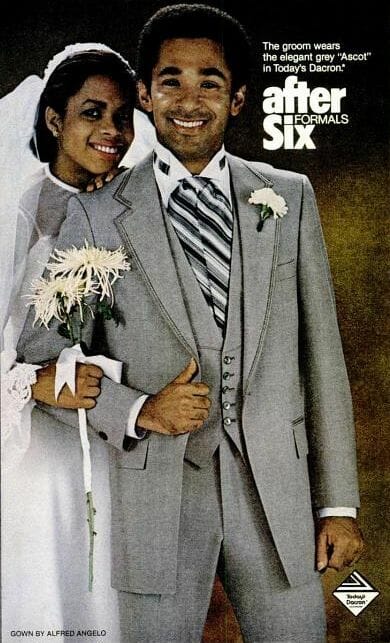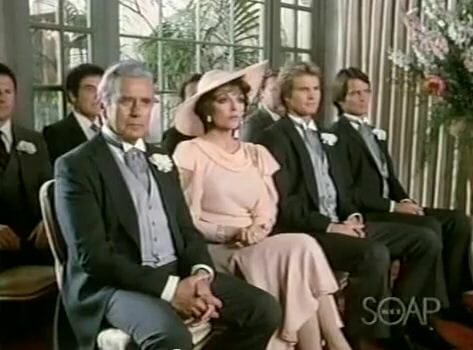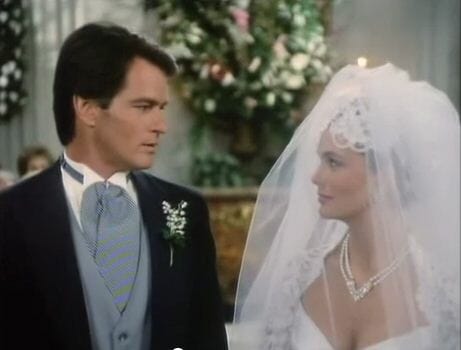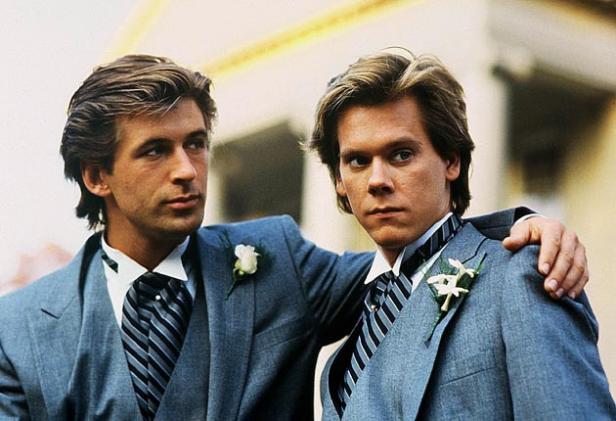
Following World War Two, menswear in the United States broke away from Old World stylings and began to fashion a distinctly American emphasis on athleticism, youthfulness and informality. This marked the beginning of the end for Morning Dress which became increasingly relegated to the role of wedding attire. By the 1960s even that role was rapidly fading as the cutaway was replaced by the tuxedo in conservative circles and by hippie fashions among the counterculture generation that wanted nothing to do with traditional church weddings.
Then along came the insatiable Yuppie appetite for luxury and nostalgia for the past. Beginning in the late 1970s there was a renaissance of conventional wedding ceremonies and the virtually extinct attire that went with them. By the 1980s cutaways and even strollers were appearing in formalwear ads, on TV and in movies.



Sadly, the revival of the practice in film and television did not catch on among the general populace. In fact, the most popular groom attire in the 1980s was the all-white tailcoat abomination. And so, American morning dress quietly slipped back into obscurity by the end of the decade.
I’ve actually been to a Morning Dress wedding in the U.S. Somewhat surprisingly, it was quite well done. It is truly a travesty to have all but lost that tradition here.
You will still see Morning Dress in Europe, affairs of state in the Americas, and in a few of the more well-dressed social circles…
Very true. In fact, it’s required for attendance of a private New Year’s day party I go to every year.
I’ve seen quite a few pictures from weddings here in Finland where the groom wore morning dress. I wouldn’t say it’s all that common or that they’re doing it because it’s “traditional” though.
Most likely it’s because they want something that differs from a regular suit.
It’s sort of like a “rented wedding costume”, much like the pastel colored tuxedos of the 80’s.
I suggest you, in the morning dress section in the guide, write a few paragraphs about the Frock coat and its contemporary interpretation.
Also, in the history section add a complete page of pre-regency formal dress, for illustrative purpose.
Some day I will likely cover the history of morning dress which will include the morning coat’s predecessor, the frock. However, the only contemporary interpretation I know of is the 1990s tuxedo alternative favoured by “creative black tie” types. That is already covered in the Contemporary Alternatives section of the Guide.
As for the early history of formal wear, I deliberately chose the Regency period as my starting point because it laid the foundations of modern White Tie and Black Tie which are the focus of the Guide.
But the history of pre-regency formal dress could be located in the supplemental
The frock coat seems to have had a bit of a renaissance as an alternative to the morning coat for wedding hire in the UK. Personally, I think it looks pretentious and, given it is hired, badly cut and badly fitting. That’s just me.
Interesting. I’ve only once worn a frock coat, and that one was actually quite nice. I would commission one if I ever had the opportunity to wear it.
There was a time in the Philippines when, after its independence from the US in 1946, morning dress with the works was de rigueur for a number of formal day-time occasions, at least until the early 1960s. By that time, national dress had supplanted the cutaway for most daytime affairs. Blame it on the climate… or attribute it to national taste (although, to be fair, when Ferdinand Marcos had his last inauguration in 1981, George H.W. Bush attended the ceremony in a cutaway despite the tropical heat).
If it’s any comfort to us in this day and age, there is no hard and fast rule about which trousers one may wear with the national tunic, although cashmere stripes will always be appropriate before 6 o’clock… and black wool with silk/satin braids after.
Yes, I have seen old footages that Philippine presidents wore cutaways, up to Magsaysay’s era. Plus, it was quite common for them to wear decorations and breast stars with their morning dresses. I can only reminisce the more genteel times of the past…
Also, I always wondered what are the appropriate trousers for the Barong Filipino. There have been no “standards” but I agree with you in conforming with Western standards. Wearing morning dress trousers for the day and the braided trousers for the evening seems sensible, since the national dress can be worn at any time of the day. It just depends if the common man had the knowledge and discretion. If only more Filipinos would just wear the national dress in proms instead of trying so hard to pull of whatever a “Tuxedo” means to them… The national dress is foolproof and patriotic at the same time. Filipinos generally suck at dressing in Western formal attire, but less than half a century ago that wasn’t the case.